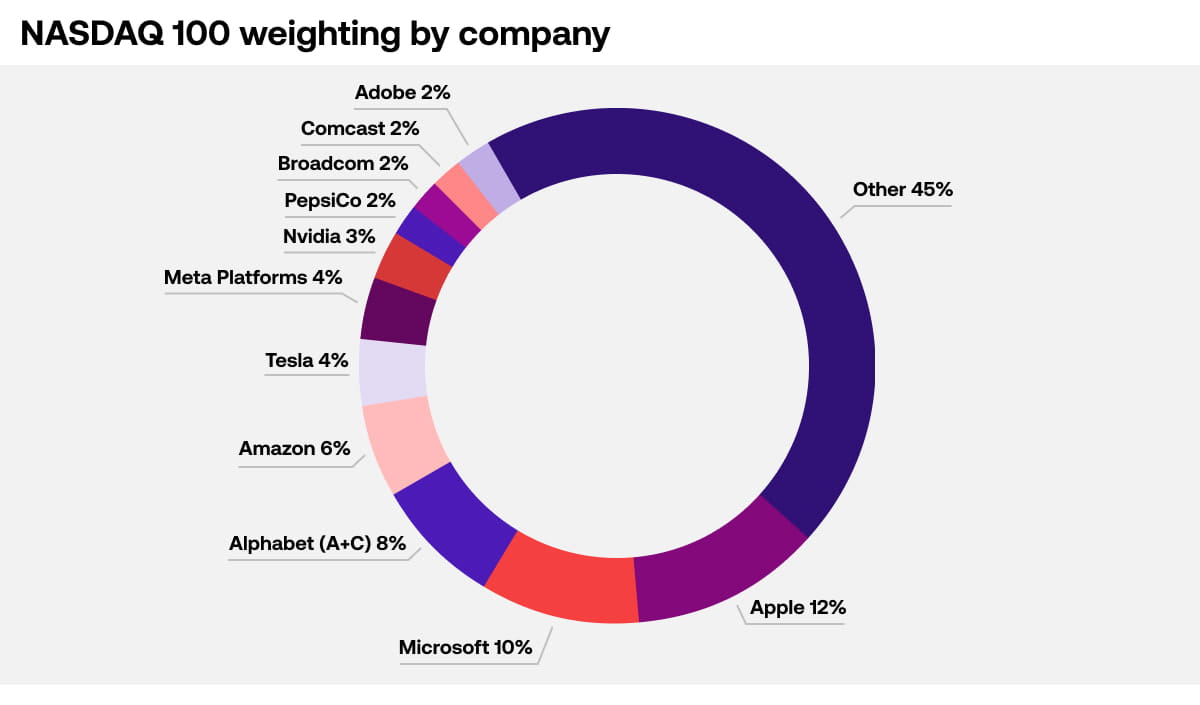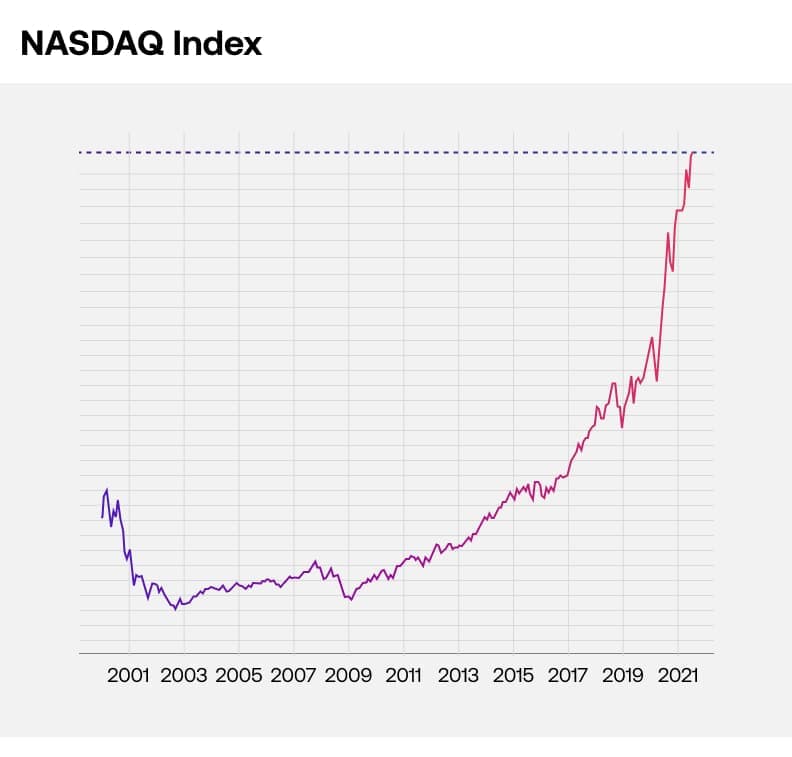- What is the Nasdaq 100?
- Nasdaq 100 constituents
- How to trade the Nasdaq 100
- Nasdaq opening hours
- How is the Nasdaq calculated?
- What moves the Nasdaq's price?
- Average returns of the Nasdaq
- Nasdaq 100 companies list
- Nasdaq FAQs
What is the Nasdaq 100?
The Nasdaq 100 is a stock index that tracks the performance of 100 of the largest US companies listed on the Nasdaq exchange, excluding financial institutions. It launched in 1985 with a value set at 250.
On your City Index account, you’ll see the Nasdaq 100 referred to as the US Tech 100.
The Nasdaq is one of three benchmark US indices, alongside the S&P 500 and the Dow Jones.
The Nasdaq exchange is home to several indices. As well as the Nasdaq 100, you may often see the Nasdaq Composite index quoted, which includes almost all companies listed on the exchange. The Nasdaq Financial, meanwhile, includes financial institutions alongside other companies.
Nasdaq 100 constituents
The Nasdaq 100 is home to some of the largest tech companies on the planet, including:
- Apple
- Microsoft
- Alphabet
- Amazon
- Paypal
- Adobe
- Peloton
- Tesla
Constituents are chosen for inclusion according to strict criteria. They need to have been listed on the Nasdaq exchange for a minimum of two years, have an average daily volume of at least 200,000 shares, submit timely quarterly and annual reports, not being in bankruptcy proceedings and more.
Here’s how the Nasdaq 100 company composition looked as of June 10 2021.

Take a look at every company listed on the Nasdaq in 2021.
How often do Nasdaq companies change?
The Nasdaq 100 is rebalanced annually each December. At this point, the top 75 companies by market capitalisation are selected for inclusion, followed by the inclusion of other companies that were already members and are ranked within the top 100.
If, following this, fewer than 100 companies pass the criteria, companies in the wider index ranked in positions 101-125 that were ranked in the top 100 at the previous reconstitution are considered, followed by companies ranked in the top 100 that were not already members as of the reconstitution date.
How to trade the Nasdaq index
You can’t trade the Nasdaq 100 directly, as there’s no asset to trade. It’s only a number that tracks the performance of a group of shares, like any stock index. However, there are several forms of derivatives and funds that will allow you to take your position on where it’s headed next.
Let’s run through how you can trade the Nasdaq using CFDs, ETFs and Knockout Options.
Nasdaq cash CFDs
A Nasdaq cash CFD is an instrument that always tracks the live price of the Nasdaq 100. You buy CFDs to take a long position, or sell them to go short.
To close your position, you trade in the opposite direction.
Learn more about CFDs.
Nasdaq Knockout Option
Knockout options are options trades with a unique feature whereby the price moves one-for-one with the underlying City Index price and provide access to higher leverage whilst limiting your risk.
The Nasdaq is available to trade as a Knockout option.
Nasdaq stock CFDs
Instead of using a derivative that tracks the entire index, you could trade Nasdaq stocks. To get exposure to the whole index, though, you need to buy 100 stock CFDs at once.
Learn more about shares.
Nasdaq 100 opening hours
Like other US indices, the standard trading hours of the Nasdaq 100 follow the main US stock exchanges: 22:30 to 05:00 (SGT) Monday to Saturday.
Premarket trading can open at 17:00 SGT and post-market trading can run through to 09:00 SGT.
With a City Index account, you can trade the index 24-hours a day Monday to Saturday.
Learn more about stock market hours.
How is the Nasdaq 100 calculated?
The Nasdaq 100 is calculated based on the market capitalisation of its participants, in what is referred to as a modified capitalisation-weighted model.
The value of the index is determined using the aggregate index share weight value of each of the constituents, multiplied by last closing price of each constituent and divided by an index divisor. Each company has a maximum weighting of 24%.
Find out more about how indices work here.
What moves the Nasdaq's price?
Anything that impacts the companies listed on the Nasdaq is likely to have an effect on its price. If a booming global economy sees businesses thrive, the Nasdaq will probably rise too. Rising regulation and slowing growth, on the other hand, will often see the Nasdaq fall.
It’s worth noting that the Nasdaq can sometimes react to news or events in surprising ways. With so many companies involved, a factor that looks like it should benefit the index could in fact send it downwards.
With that in mind, here are three things to watch out for when trading the Nasdaq:
- Monetary and economic releases
- Tech sector performance
- Global events
The US Federal Reserve probably has the single greatest say over whether the US stock market is going to go up or down. Chiefly, because it sets monetary policy: including interest rates.
Low interest rates encourage borrowing, spending and investing in stocks. These are the conditions in which shares often thrive. Companies can borrow cheaply and grow, while customers are more likely to buy products. High rates, on the other hand, do the opposite – putting a brake on the economy, with a negative effect on businesses.
Because of this, index traders are constantly watching for any sign that the Fed might be about to change rates. As well as the Fed’s meetings themselves, they’ll analyse economic releases such as inflation reports and non-farm payrolls so they can try and predict what the Fed will do next.
Take another look at the Nasdaq company breakdown above. Notice that the companies making up most of the index’s weighting are in the tech sector?
This gives the Nasdaq a strong exposure to the ups and downs of tech companies. The FAAMG stocks alone, for instance, make up some 40% of the index’s price movements on any given day. Where big US tech firms lead, the Nasdaq usually follows.
The lockdowns of 2020 and 2021, for example, saw the Nasdaq’s value soar – partially because tech firms did so well out of the stay-at-home economy.
We’ve seen how global events can boost the Nasdaq. But often, geopolitical risk can see the index hit some of its biggest bear markets. Before the highs of late 2020, it shed around 40% of its value due to growing fears surround COVID-19.
The 2008 crash, too, saw the Nasdaq drop to multi-year lows. Take a look at a long-term Nasdaq chart, and the significant dips you see breaking up the bull runs are probably due to global events.

Average returns of the Nasdaq index
Over the last ten years, the Nasdaq 100 has produced an average annual return of 18.2%. Essentially that means that you’d have earned an 18.2% return on average each year if you’d invested in the index directly.
That compares favourably to other indices: the Dow Jones has an average return of 10.7% for the same period, while the DAX’s is 8.2%. Remember, though, that past returns are no guarantee of future performance.
Nasdaq 100 companies list
The below chart shows the top 20 companies in the Nasdaq 100, correct as of June 14 2021. At the point captured, the top ten alone made up over 65% of the weighting for the entire index, illustrating the influence these companies can have on the whole benchmark.
Rank |
Ticker |
Company name |
Weighting |
|---|---|---|---|
| 1 | AAPL | Apple | 10.8% |
| 2 | MSFT | Microsoft | 9.7% |
| 3 | AMZN | Amazon | 8.4% |
| 4 | GOOG | Alphabet (Class C shares) | 4.1% |
| 5 | FB | 4% | |
| 6 | GOOGL | Alphabet (Class A shares) | 3.7% |
| 7 | TSLA | Tesla | 3.6% |
| 8 | NVDA | NVIDIA Corp | 3.3% |
| 9 | PYPL | PayPal | 1.3% |
| 10 | CMCSA | Comcast | 2.4% |
| 11 | ADBE | Adobe | 1.9% |
| 12 | INTC | Intel | 1.8% |
| 13 | CSCO | Cisco | 1.8% |
| 14 | NFLX | Netflix | 1.7% |
| 15 | PEP | PepsiCo | 1.6% |
| 16 | AVGO | Broadcom | 1.5% |
| 17 | TMUS | T-Mobile US. | 1.4% |
| 18 | TXN | Texas Instruments | 1.3% |
| 19 | COST | Costco. | 1.3% |
| 20 | QCOM | QUALCOMM | 1.2% |
Nasdaq FAQs
What is the US Tech 100?
The US Tech 100 is City Index’s name for its market on the Nasdaq 100. If you want to trade the Nasdaq, then you’d trade the US Tech 100.
How do I short the Nasdaq 100?
Shorting the Nasdaq 100 involves taking a position that the index will fall. This can be done by selling short a Nasdaq 100 CFD or shorting constituent stocks via CFDs. Alternatively, traders may be interested in shorting a Nasdaq 100 ETF.
Read more about shorting a market.
What does the Nasdaq price mean?
The price of the Nasdaq 100 indicates whether the share prices of the companies on the index are rising or falling. If the price of the Nasdaq 100 is increasing, it means that a specific company or group of companies are experiencing gains, which is reflected in the price of the overall index. Conversely, if the Nasdaq 100 price is falling, it means that companies on the index are experiencing a decline in price.
The Nasdaq 100 ranking is based on a weighted average of share prices. This means companies with a larger weighting will often see their share price fluctuations have a correspondingly outsized impact on the wider index.
See live Nasdaq 100 prices.









